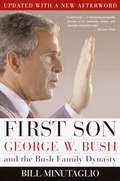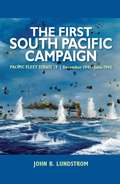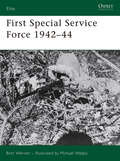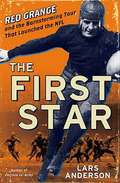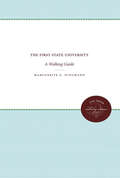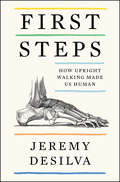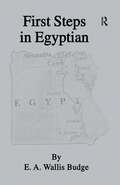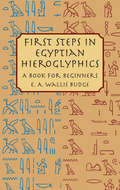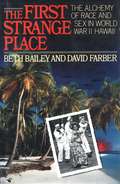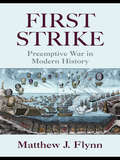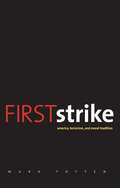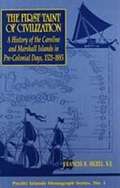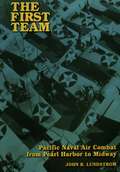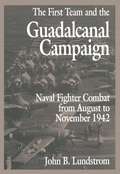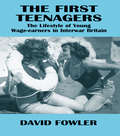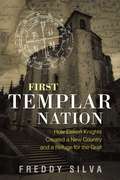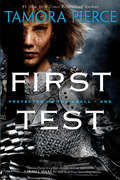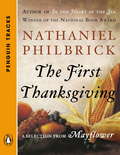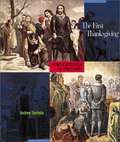- Table View
- List View
First Son: George W. Bush and the Bush Family Dynasty
by Bill MinutaglioMinutaglio, a Texas journalist who has worked for some of the state's major newspapers, tells the story of a powerful political family, beginning with the turn-of-the-century emergence of the influential Bush-Walker clan and of Prescott Bush, the Connecticut patrician who ingrained in his family an ethos that continues to exert influence on his son, former President George Bush, and his grandsons Jeb and George W. Bush. How these scions of the Bush dynasty struggle to live up to their legacy is the cen...
The First South Pacific Campaign
by John B. LundstromOn May 7 and 8, 1942, fast carrier task forces from the United States and Imperial Japanese navies met in combat for the first time in the Battle of the Coral Sea. A strategic victory for the U.S. in spite of the loss of the carrier Lexington, the destroyer Sims and the fleet oiler Neosho, the battle blunted the Japanese drive on Port Moresby, a valuable Allied air and naval base controlling the western Coral Sea and northern Australia.John B. Lundstrom offers a detailed analysis of the fundamental strategies employed by Japan and the U.S. in the South Pacific from January to June 1942, including Japanese equivocation regarding advances in the South Pacific and the vigorous actions of Admiral Ernest J. King to reinforce the area in spite of the presidential decision to concentrate American efforts on Europe and the problem of Germany.Writing in a clear, concise, and readable style, Lundstrom combines strategic insight and careful scholarship with previously untapped source materials to present a book that provides a superb overview of the first six months of the naval war in the South Pacific. First published in 1976, The First South Pacific Campaign is essential reading for a full understanding of the Pacific Fleet's strategy before the Battle of Midway.
First Special Service Force 1942-44
by Bret Werner Michael WelplyThis is a concise history of the unique integrated commando-style brigade of US and Canadian volunteers formed in 1942. Hand picked, and trained in airborne, amphibious, mountain and winter warfare, demolitions and close-quarter tactics, they left a combat legacy still recognized amongst today's Special Forces. This book explores the remarkable results the FSSF achieved in Italy - in the harsh mountain fighting on the Winter Line, in the trenches of Anzio, and in the breakthrough to Rome. Accompanied by unique combat photography and illustrations of their distinctive uniforms, this is an insight into a famous, but little explored unit.
The First Stampede of Flores LaDue
by Wendy BrydenThe true love story of Florence and Guy Weadick, in celebration of the Centenary of the Calgary Stampede, 1912 - 2012.The love story of rodeo promoter Guy Weadick and trick roper Flores LaDue began among the rough-and-tumble vaudevillians who preserved the frontier way of life in the first Wild West shows. Their love endured through North American performances in the small-time and big-time circuits, to the audiences of Europe, and culminated in 1912 with the most spectacular of accomplishments - the establishment of the greatest outdoor show on earth, the Calgary Stampede.
The First Star: Red Grange and the Barnstorming Tour that Launched the NFL
by Lars AndersonAcclaimed sportswriter Anderson recounts the thrilling story of Harold "Red" Grange, the Galloping Ghost of the gridiron, and the wild barnstorming tour that earns professional football a place in the American sporting firmament.
The First State University: A Walking Guide
by Marguerite E. SchumannIn a convenient format, Schumann offers a guide to the campus of the University of North Carolina and immediately adjacent areas in Chapel Hill that will be indispensable for walkers wishing to acquaint themselves with the University and its history. In the revised edition, she has added two hour-long walks to the four presented in the original volume, included several sites that can be conveniently toured by car, and added thirty new buildings (for a total of ninety). She includes new structures in the historic districts of the campus as well as points of interest on South Campus, where the medical complex is located.Originally published in 1985.A UNC Press Enduring Edition -- UNC Press Enduring Editions use the latest in digital technology to make available again books from our distinguished backlist that were previously out of print. These editions are published unaltered from the original, and are presented in affordable paperback formats, bringing readers both historical and cultural value.
First Steps: How Upright Walking Made Us Human
by Jeremy DeSilvaWinner of the W.W. Howells Book Prize from the American Anthropological Association and named one of the best science books of 2021 by Science News“DeSilva takes us on a brilliant, fun, and scientifically deep stroll through history, anatomy, and evolution, in order to illustrate the powerful story of how a particular mode of movement helped make us one of the most wonderful, dangerous and fascinating species on Earth.”—Agustín Fuentes, Professor of Anthropology, Princeton University and author of Why We Believe: Evolution and the Human Way of Being“Breezy popular science at its best. . . . Makes a compelling case overall.”—Science NewsBlending history, science, and culture, a stunning and highly engaging evolutionary story exploring how walking on two legs allowed humans to become the planet’s dominant species.Humans are the only mammals to walk on two, rather than four legs—a locomotion known as bipedalism. We strive to be upstanding citizens, honor those who stand tall and proud, and take a stand against injustices. We follow in each other’s footsteps and celebrate a child’s beginning to walk. But why, and how, exactly, did we take our first steps? And at what cost? Bipedalism has its drawbacks: giving birth is more difficult and dangerous; our running speed is much slower than other animals; and we suffer a variety of ailments, from hernias to sinus problems.In First Steps, paleoanthropologist Jeremy DeSilva explores how unusual and extraordinary this seemingly ordinary ability is. A seven-million-year journey to the very origins of the human lineage, First Steps shows how upright walking was a gateway to many of the other attributes that make us human—from our technological abilities, our thirst for exploration, our use of language–and may have laid the foundation for our species’ traits of compassion, empathy, and altruism. Moving from developmental psychology labs to ancient fossil sites throughout Africa and Eurasia, DeSilva brings to life our adventure walking on two legs.Delving deeply into the story of our past and the new discoveries rewriting our understanding of human evolution, First Steps examines how walking upright helped us rise above all over species on this planet.First Steps includes an eight-page color photo insert.
First Steps In Egyptian: A Book For Beginners (Egypt Ser.)
by BudgeFirst published in 2005. Routledge is an imprint of Taylor & Francis, an informa company.
First Steps in Egyptian Hieroglyphics: A Book for Beginners (Egypt Ser.)
by E. A. Wallis BudgeAnyone curious about hieroglyphics will appreciate this classic primer. This practical grammar comprises lists of frequently used signs and determinatives, a vocabulary of about 500 words, a series of 31 texts and extracts (with interlinear transliteration and word-for-word translation), and a few untransliterated and untranslated texts (with glossary), to be worked out independently.
The First Strange Place: The Alchemy of Race and Sex in World War II Hawaii
by Beth Bailey David FarberJust as World War I introduced Americans to Europe, making an indelible impression on thousands of farmboys who were changed forever "after they saw Paree," so World War II was the beginning of America's encounter with the East - an encounter whose effects are still being felt and absorbed. No single place was more symbolic of this initial encounter than Hawaii, the target of the first unforgettable Japanese attack on American forces, and, as the forward base and staging area for all military operations in the Pacific, the "first strange place" for close to a million soldiers, sailors, and marines on their way to the horrors of war. But as Beth Bailey and David Farber show in this evocative and timely book, Hawaii was also the first strange place on another kind of journey, toward the new American society that began to emerge in the postwar era. Unlike the largely rigid and static social order of prewar America, this was to be a highly mobile and volatile society of mixed racial and cultural influences, one above all in which women and minorities would increasingly demand and receive equal status. With consummate skill and sensitivity, Bailey and Farber show how these unprecedented changes were tested and explored in the highly charged environment of wartime Hawaii. Most of the hundreds of thousands of men and women whom war brought to Hawaii were expecting a Hollywood image of "paradise." What they found instead was vastly different: a complex crucible in which radically diverse elements - social, racial, sexual - were mingled and transmuted in the heat and strain of war. Drawing on the rich and largely untapped reservoir of documents, diaries, memoirs, and interviews with men and women who were there, the authors vividly recreate the dense, lush, atmosphere of wartime Hawaii - an atmosphere that combined the familiar and exotic in a mixture that prefigured the special strangeness of American society today.
The First Strange Place
by Beth Bailey David FarberJust as World War I introduced Americans to Europe, making an indelible impression on thousands of farmboys who were changed forever "after they saw Paree," so World War II was the beginning of America's encounter with the East - an encounter whose effects are still being felt and absorbed. No single place was more symbolic of this initial encounter than Hawaii, the target of the first unforgettable Japanese attack on American forces, and, as the forward base and staging area for all military operations in the Pacific, the "first strange place" for close to a million soldiers, sailors, and marines on their way to the horrors of war. But as Beth Bailey and David Farber show in this evocative and timely book, Hawaii was also the first strange place on another kind of journey, toward the new American society that began to emerge in the postwar era. Unlike the largely rigid and static social order of prewar America, this was to be a highly mobile and volatile society of mixed racial and cultural influences, one above all in which women and minorities would increasingly demand and receive equal status. With consummate skill and sensitivity, Bailey and Farber show how these unprecedented changes were tested and explored in the highly charged environment of wartime Hawaii. Most of the hundreds of thousands of men and women whom war brought to Hawaii were expecting a Hollywood image of "paradise." What they found instead was vastly different: a complex crucible in which radically diverse elements - social, racial, sexual - were mingled and transmuted in the heat and strain of war. Drawing on the rich and largely untapped reservoir of documents, diaries, memoirs, and interviews with men and women who were there, the authors vividly recreate the dense, lush, atmosphere of wartime Hawaii - an atmosphere that combined the familiar and exotic in a mixture that prefigured the special strangeness of American society today.
First Strike: Preemptive War in Modern History
by Matthew J. FlynnPreemptive warfare is the practice of attempting to avoid an enemy’s seemingly imminent attack by taking military action against them first. It is undertaken in self-defense. Preemptive war is often confused with preventive war, which is an attack launched to defeat a potential opponent and is an act of aggression. Preemptive war is thought to be justified and honorable, while preventive war violates international law. In the real world, the distinction between the two is highly contested. In First Strike, Matthew J. Flynn examines case studies of preemptive war throughout history, from Napoleonic France to the American Civil War, and from Hitler’s Germany to the recent U.S. invasion of Iraq. Flynn takes an analytical look at the international use of military and political preemption throughout the last two hundred years of western history, to show how George W. Bush’s recent use of this dubiously "honorable" way of making war is really just the latest of a long line of previously failed attempts. Balanced and historically grounded, First Strike provides a comprehensive history of one of the most controversial military strategies in the history of international foreign policy.
First Strike: America, Terrorism, and Moral Tradition
by Mark TottenCan the use of force first against a less-than-imminent threat be both morally acceptable and consistent with American values? In this timely book Mark Totten offers the first in-depth, historical examination of the use of preemptive and preventive force through the lens of the just war tradition. Although critical of the American incursion into Iraq as a so-called "preemptive war," Totten argues that the new terrorist threat nonetheless demands careful consideration of when the first use of force is legitimate. The moral tradition, he concludes, provides a principled way forward that reconciles American values and the demands of security.
The First Taint of Civilization: A History of the Caroline and Marshall Islands in Pre-Colonial Days, 1521-1885
by Francis X. HezelHezel begins with Magellan's discovery of Guam and details the history of the islands up to the establishment of the German Protectorate in the Marshalls.
The First Team
by John B. LundstromHailed as one of the finest examples of aviation research, this comprehensive 1984 study presents a detailed and scrupulously accurate operational history of carrier-based air warfare. From the earliest operations in the Pacific through the decisive Battle of Midway, it offers a narrative account of how ace fighter pilots like Jimmy Thach and Butch O'Hare and their skilled VF squadron mates - called the "first team" - amassed a remarkable combat record in the face of desperate odds. Tapping both American and Japanese sources, historian John B. Lundstrom reconstructs every significant action and places these extraordinary fighters within the context of overall carrier operations. He writes from the viewpoint of the pilots themselves, after interviewing some fifty airmen from each side, to give readers intimate details of some of the most exciting aerial engagements of the war. At the same time he assesses the role the fighter squadrons played in key actions and shows how innovations in fighter tactics and gunnery techniques were a primary reason for the reversal of American fortunes. After more than twenty years in print, the book remains the definitive account and is being published in paperback for the first time to reach an even larger audience.
First Team and the Guadalcanal Campaign
by John B. LundstromFrom huddled command conferences to cramped cockpits, John Lundstrom guides readers though the maelstrom of air combat at Guadalcanal in this impressively researched sequel to his earlier study. Picking up the story after Midway, the author presents a scrupulously accurate account of what happened, describing in rich detail the actual planes and pilots pitted in the ferocious battles that helped turn the tide of war. Based on correspondence with 150 American and Japanese veterans, or their families, he reveals the thoughts, pressures, and fears of the airmen and their crews as he reconstructs the battles. These are the stories of the Wildcat and Zero fighters, and the Dauntless, Avenger, Betty, Kate, and Val bombers. Lavishly illustrated with drawings, maps, and photographs, this fresh look at the campaign set a standard for aviation histories when first published in 1994.
The First Teenagers: The Lifestyle of Young Wage-earners in Interwar Britain
by David FowlerFirst Published in 1996. Routledge is an imprint of Taylor & Francis, an informa company.
First Templar Nation: How Eleven Knights Created a New Country and a Refuge for the Grail
by Freddy SilvaOverturns the long-established historical narrative about the origins and purpose of the Knights Templar • Explains how and why the Templars created Europe’s first nation-state, Portugal, with one of their own as king • Reveals the Portuguese roots of key founding members, their relationship with the Order of Sion, the Templars’ devotion to Mary Magdalene and John the Baptist, and the meaning and exact location of the Grail • Provides evidence of Templar holy sites and hidden chambers throughout Portugal • Includes over 700 references, many from new and rare sources Conventional history claims that nine men formed a brotherhood called the Knights Templar in Jerusalem in 1118 to provide protection for pilgrims traveling to the Holy Land. Overturning this long-established historical narrative, Freddy Silva shows that the Order of the Temple existed a decade earlier on the opposite side of Europe, that the protection of pilgrims was entrusted to a seperate organization, and that, in league with the Cistercian monks and the equally mysterious Order of Sion, the Templars executed one of history’s most daring and covert plans: the creation of Europe’s first nation-state, Portugal, with one of their own as king. Including over 700 references, many from new and rare sources, Silva reveals Portugal, not Jerusalem, as the first Templar stronghold. He shows how there were eleven founding members and how the first king of Portugal, a secret Templar, was related to Bernard de Clairvaux, head of the Cistercians. The author explains the Templars’ motivation to create a country far from the grasp of Rome, where they could conduct their living resurrection initiation--whose candidates were declared “risen from the dead”--a secret for which the Church silenced millions and which the Templars protected to the death. Placing the intrepid Knights in a previously unknown time and place, Silva’s historical narrative reveals the Portuguese roots of key founding members, their relationship with the Order of Sion, the Templars’ unshakeable devotion to Mary Magdalene and John the Baptist, and how they protected a holy bloodline in Portugal. He also provides evidence of secret Templar holy sites, initiation chambers, and hidden passageways throughout Portugal, often coinciding with pagan and Neolithic temples, and explains how their most important site forms a perfect triangle with the Abbey of Mont Sion in Jerusalem and the Osirion temple in Egypt. The author also reappraises the meaning of the Grail and reveals its exact location, hidden in plain sight to this very day.
First Test: Book 1 of the Protector of the Small Quartet (Protector of the Small #1)
by Tamora PierceTamora Pierce returns to the land of Tortall with a heroine who refuses to quit in this first book in the #1 New York Times bestselling Protector of the Small series.Ten years after knighthood training was opened to both males and females, no girl has been brave enough to try. But knighthood is Keladry's one true desire, and so she steps forward to put herself to the test.Up against the traditional hazing of pages and a grueling schedule, Kel faces one roadblock that seems insurmountable: Lord Wyldon, the training master of pages and squires. He is absolutely against girls becoming knights. So while he is forced to train her, Wyldon puts her on a probationary trial period that no male page has ever had to endure. Further set apart from her fellow trainees, Kel's path to knighthood is now that much harder. But she is determined to try, and she's making friends in the most unlikely places. One thing is for sure, Kel is not a girl to underestimate.From the Hardcover edition.
The First Thanksgiving
by Jean Craighead GeorgeDescribes how the colonists aboard the Mayflower founded New Plymouth and celebrated their first harvest with a feast of thanksgiving.
The First Thanksgiving
by Nathaniel PhilbrickThe real story of the First Thanksgiving from the New York Times bestselling author Nathaniel Philbrick One of America's most acclaimed historians takes on the nation's First Thanksgiving, telling us the true story behind the tale we think we know so well. In this selection from the New York Times bestseller Mayflower Nathaniel Philbrick recounts in riveting detail the truth about relations between Plymouth Colony and the British crown and between the colonists and Native American tribes, shining a light on the courage, communities, and conflicts that shaped one of our country's most celebrated national holidays.
The First Thanksgiving (Cornerstones of Freedom, 2nd Series)
by Andrew SantellaDiscusses the history of New Plymouth Colony in Massachusetts, the relationship between the colonists and the native Wampanoag people, and the harvest festival which would later become Thanksgiving Day.
